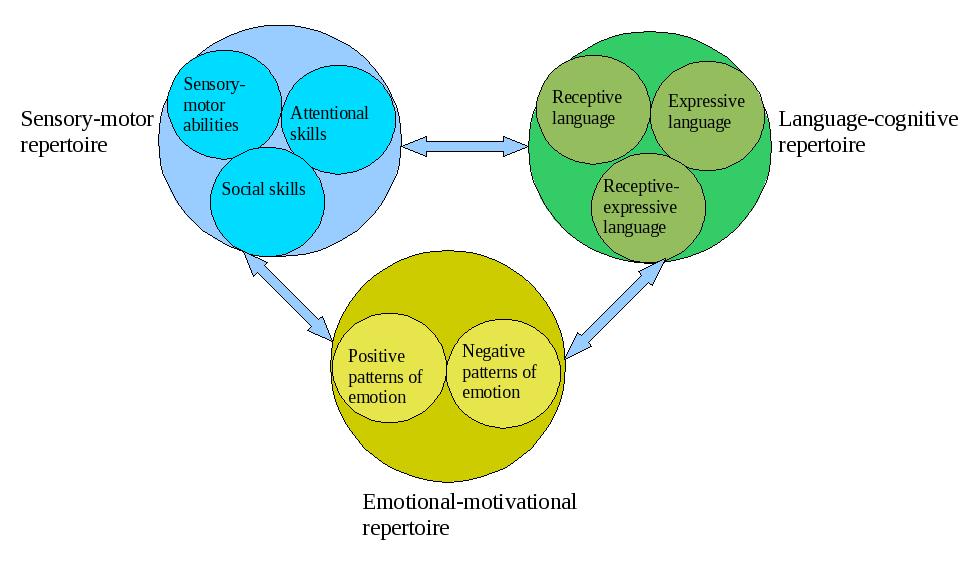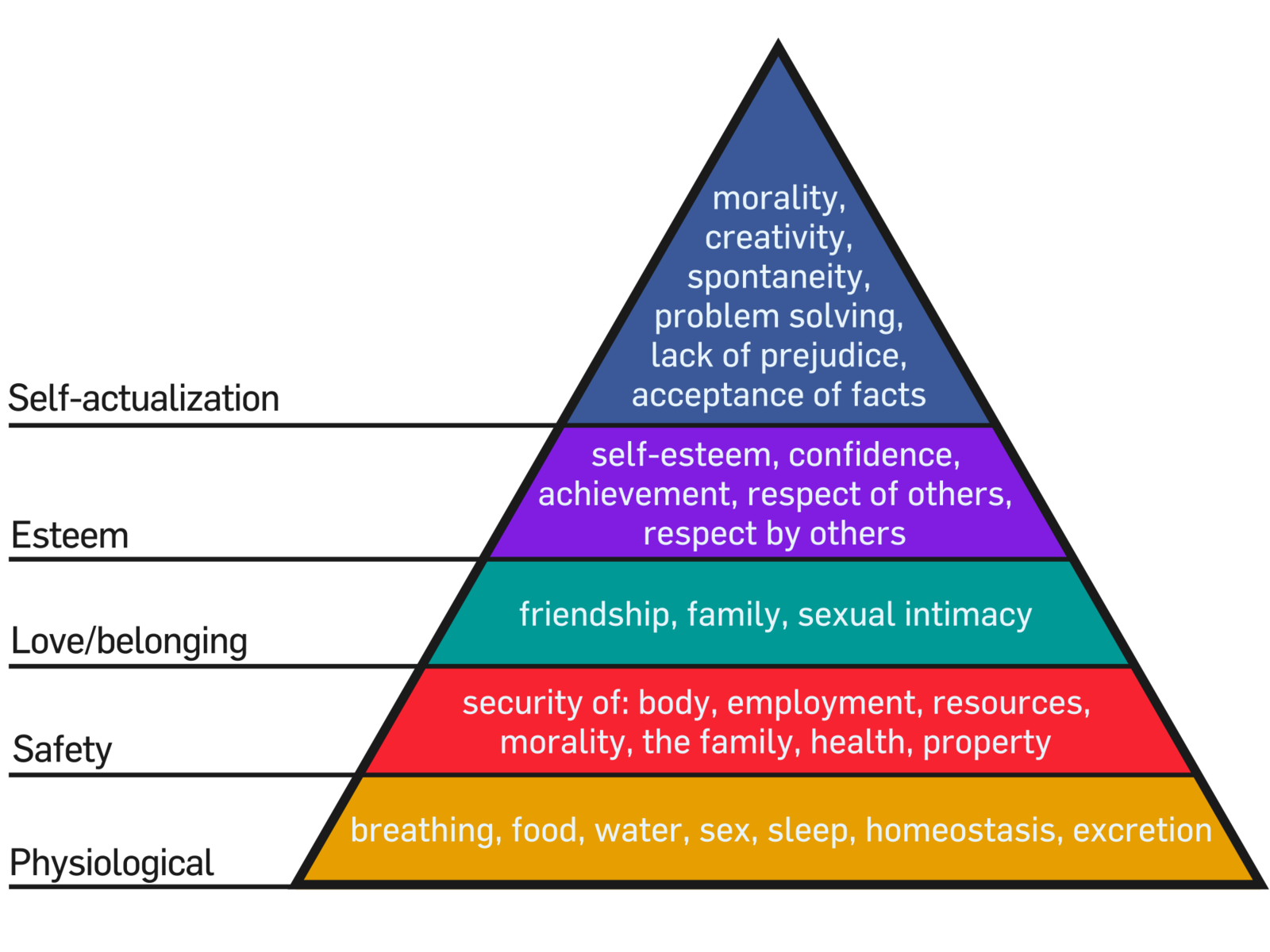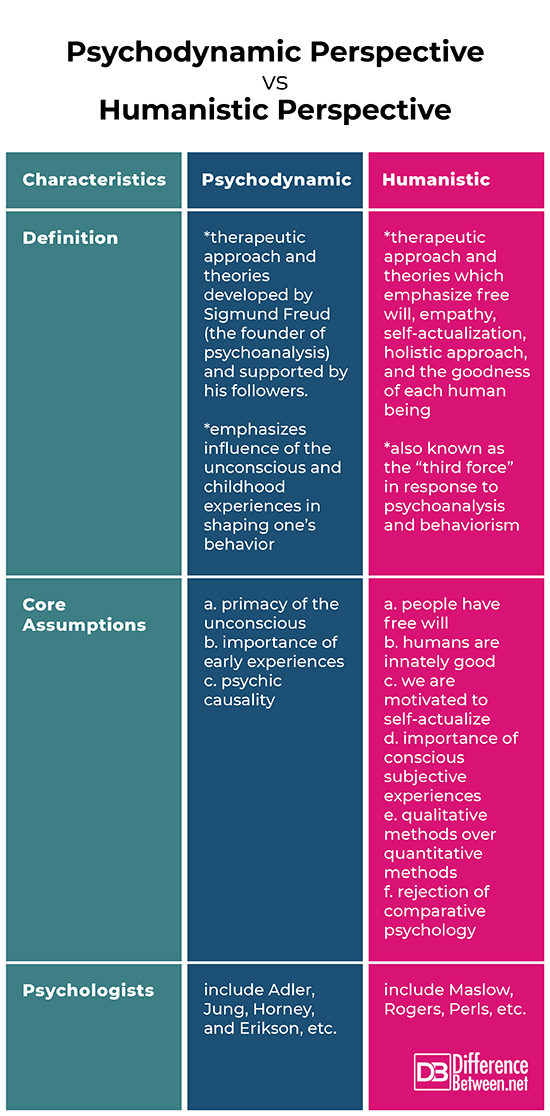Difference Between Psychodynamic Perspective and Humanistic Perspective
Psychodynamic and humanistic perspectives have been remarkably essential in understanding behavior. Psychodynamic perspective focuses on the influence of unconscious psychological processes while humanistic perspective investigates the impact of our free will, the importance of personal worth, and the centrality of human values. The following discussions further delve into their distinctions.

What is Psychodynamic Perspective?
The psychodynamic perspective pertains to the therapeutic approach and theories developed by Sigmund Freud (the founder of psychoanalysis) and supported by his followers. The neo-Freudians agreed with the fundamental principles of the psychoanalytic theory such as the influence of the unconscious and childhood experiences. However, they disagreed with some of his concepts; generally, they deemphasized the role of sex and acknowledged the impact of social environment.
Some of the neo-Freudians are the following:
- Alfred Adler
Adler, an Austrian psychiatrist, developed “Individual Psychology”. He was initially a part of Freud’s inner circle of colleagues. However, Adler disagreed with Freud’s emphasis on sexual and aggressive urges. He believed that individuals are driven by feelings of inferiority in childhood and that they should be studied as a whole.
- Carl Jung
Jung, a Swiss psychiatrist, developed “Analytical Psychology”. He had a close friendship with Freud but it ended due to their differing concepts. Jung described Freud’s theory of the unconscious as incomplete and too pessimistic. For example, Jung suggested the existence of the “collective unconscious” which is transpersonal and deeper. However, Freud dismissed such concepts as being irrational.
- Karen Horney
Horney (“horn-eye”), a German psychoanalyst, is credited for her feminist psychology. She disagreed with the concept of “penis envy” ( Freud explained that young girls experience anxiety when they realize that they do not have a penis). Horney then explained that men go through “womb envy” (men are actually envious of women’s capability to bear children). She also believed that neurosis is attributed to the basic anxiety which stem from interpersonal relationships.
The core assumptions of the psychodynamic perspective are the following (Bornstein, 2020):
- Primacy of the Unconscious
The psychodynamic perspective explains that our psychological processes our largely unconscious. For instance, we are not consciously aware of most of our feelings, motives, memories, and other mental activities.
- Importance of Early Experiences
Psychodynamic theorists view childhood experiences, including those that occur during the first weeks of life as crucial in shaping personality. For instance, not experiencing sufficient care from a primary caregiver can negatively affect one’s behavior, even decades later.
- Psychic Causality
The psychodynamic perspective suggests that behavior is caused by certain biological and psychological processes. Hence, every thought, feeling, or motive does not just happen by chance; everything has a meaning. For instance, dreams are not merely meaningless images or stories, they may say something about your desires, fears, past, etc.

What is Humanistic Perspective
The humanistic perspective emphasizes free will, empathy, self-actualization, holistic approach, and the goodness of each human being. It is also known as the “third force”, it arose in the 1950s in response to psychoanalytic and behavioral perspectives which are described as too deterministic. For instance, it sees the psychodynamic perspective as having too much focus on the unconscious. It also sees behaviorism as having too much emphasis on reinforcement, punishment, and animal research. Humanistic psychologists include Abraham Maslow, Carl Rogers, and Fritz Perls.
The following are humanism’s basic assumptions (McLeod, 2020):
- People have free will
Humans have the capacity to choose how they will respond to stimuli. For instance, we can choose to be happy despite challenging situations.
- Humans are innately good and have the need to make themselves and others better
Good intentions are the driving force of behavior; however, individuals may deviate from their innate goodness when facing adverse situations. We can then change for the better and will ourselves to overcome challenges.
- Humans are motivated to self-actualize
People continuously seek to achieve growth, satisfaction, and fulfillment.
- Conscious subjective experiences are the most important
Instead of focusing on the unconscious, rewards and punishments, thinking, or the human brain, we should look into how people interpret events, each individual’s unique understanding of the world.
- Qualitative methods over quantitative methods
As compared to laboratory experiments and surveys, the use of diary accounts, open-ended questionnaires, in-depth and unstructured interviews and observations are more productive in studying behavior. Humans can be better understood by genuinely talking with them, being open, and empathetic.
- Comparative psychology does not explore humans’ unique properties
Humanism views studies on animals as insignificant since they do not tell us much about how humans feel, think, and experience events.
Difference between Psychodynamic Perspective and Humanistic Perspective
Definition
The psychodynamic perspective pertains to the therapeutic approach and theories developed by Sigmund Freud (the founder of psychoanalysis) and supported by his followers. It emphasizes the influence of the unconscious and childhood experiences in shaping one’s behavior. In comparison, the humanistic perspective emphasizes free will, empathy, potential, holistic approach, and the goodness of each human being. It is also known as the “third force”, it arose in response to both psychoanalytic and behavioral perspectives which are described as too deterministic.
Core Assumptions
The core assumptions of psychodynamic perspective are: primacy of the unconscious, importance of early experiences, and psychic causality (Bornstein, 2020). On the other hand, the basic assumptions of humanistic perspective are: people have free will, humans are innately good, we are motivated to self-actualize, conscious subjective experiences are more important, qualitative methods over quantitative methods, and rejection of comparative psychology (McLeod, 2020).
Psychologists
The neo-Freudians advanced the psychodynamic perspective which was based on Freud’s psychoanalysis. They include Adler, Jung, Horney, and Erikson. As for the humanistic psychologists, they include Maslow, Rogers, and Perls.
Psychodynamic Perspective vs Humanistic Perspective

Summary
- Both psychodynamic and humanistic perspectives seek to explain behavior and guide therapeutic processes.
- The psychodynamic perspective emphasizes the influence of the unconscious and childhood experiences in shaping one’s behavior.
- The humanistic perspective emphasizes free will, empathy, self-actualization, holistic approach, and the goodness of each human being
- Difference Between Hematoma and Melanoma - February 9, 2023
- Difference Between Bruising and Necrosis - February 8, 2023
- Difference Between Brain Hematoma and Brain Hemorrhage - February 8, 2023
Search DifferenceBetween.net :
Leave a Response
References :
[0]Bornstein, R. (2020). The psychodynamic perspective. In R. Biswas-Diener & E. Diener (Eds), Noba textbook series: Psychology. Champaign, IL: DEF publishers. Retrieved from http://noba.to/zdemy2cv
[1]Engler, B. (2005). Personality theories. Wadsworth Publishing.
[2]McLeod, S. (2020). Humanistic approach. Simply Psychology. https://www.simplypsychology.org/humanistic.html
[3]Image credit: https://commons.wikimedia.org/wiki/File:Maslow%27s_Hierarchy_of_Needs_Pyramid.png
[4]Image credit: https://commons.wikimedia.org/wiki/File:Psychological_behaviorism.jpg
